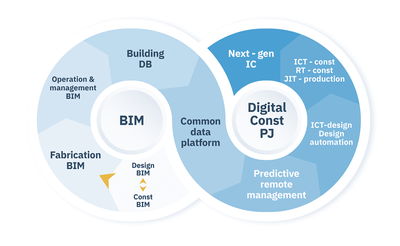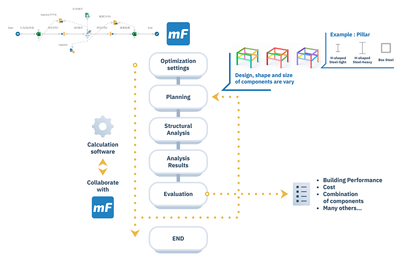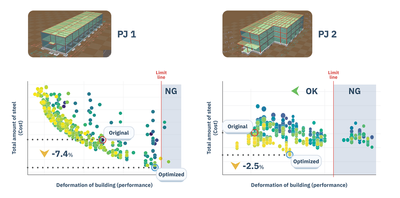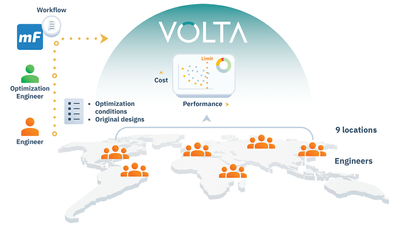Daiwa House reforms structural analysis with collaborative design optimization


- Company: Daiwa House
- ESTECO Software Solution: VOLTA
- Benefits:Simulation of 200 design alternativesDesign time reduced by up to 67%Reduction of 2100 hours to 700 hours annually
With modeFRONTIER and VOLTA, Daiwa House streamlines structural calculations, cuts costs, and enables more designers to seamlessly perform structural design optimization studies.
Daiwa House Industry Co., is a pioneer in the “industrialization” of construction in Japan, and since it was established in 1955, it has been developing and supplying high-quality housing that stresses the needs of inhabitants. Today it has grown into one of Japan’s leading home builders. It has a wide range of business developments, centered around housing and extending to the construction of shops and office buildings, and it also includes the company’s own special brand of resort operations and retail do-it-yourself home centers.
“With VOLTA, we can simulate up to 200 design alternatives — compared to just five in the traditional method — and visualize their performance clearly. It has significantly improved collaboration, decision-making, and reduced our design time by up to 67%, which amounts to a total reduction of 2100 hours to 700 hours annually across all projects.”
1. Daiwa House, digital transformation and the BIM platform
Daiwa House has embraced a digital strategy known as the Mobius Loop Concept, aiming to integrate technology across the building lifecycle. A key pillar of this approach is the internal mandate to adopt building information modeling (BIM) within its building division, initiated in 2017.
The company began developing a BIM platform to serve as a central hub for all project data. At the heart of this system lies the common data environment (CDE) — a collaborative space where all project members can manage all data related to the construction process and contribute to a unified 3D model. By minimizing the reliance on paper drawings and siloed workflows, Daiwa House has laid the foundation for efficient, data-driven decision-making across departments.

Mobius Loop - connect design & construction BIM & Digital Manufacturing
2. Structural design challenges in an earthquake-prone country
Japan’s vulnerability to seismic activity poses a unique challenge in structural engineering. Structural design in the country must meet three fundamental criteria:
2. Functional requirements: meeting the client’s expectations for performance and usability.
3. Safety: ensuring buildings can withstand frequent and potentially devastating earthquakes.
4. Economic efficiency: balancing cost-effectiveness with high structural integrity.
Traditionally, Daiwa House’s structural design process involved manual iterations: engineers created a model, ran calculations, made adjustments based on experience, and repeated the process until a final plan emerged. While this approach has served its purpose, it faced four major limitations:
- A limited number of design alternatives considered.
- Risk of missing better solutions due to fixed thinking patterns.
- Subjective decision-making based on individual judgment.
- Long lead times for design completion.
Given these limitations, the need for a more efficient structural design process became clear.

Current structural design process
3. Introducing optimization system at Daiwa House
Daiwa House turned to modeFRONTIER and VOLTA software solutions to introduce an optimization system for their structural engineering teams, allowing them to perform many simulations more quickly.
In particular, modeFRONTIER was chosen for its ability to integrate and automate structural analysis software with the aim of performing rapid, high-volume simulations and applying design optimization methods. Engineers use it to define variables such as beam and column types, run calculations, and evaluate performance across hundreds of design variants — from cost and material usage to seismic resilience.
Once a simulation workflow is created in modeFRONTIER, it is uploaded to VOLTA platform, which allows engineers across Daiwa House’s 50+ regional branches to:
- Execute the simulation workflow and apply design optimization studies remotely.
- Visualize and analyze simulation results through interactive web-based dashboards.
- Collaborate more easily by sharing design results and insights.
Case study highlights:
With the new optimization system, structural engineers analyzed two steel-framed buildings (a 2-story, 1000m² and a 3-story, 3700m² structure). Optimization objectives included minimizing the amount of steel structure (cost factor) and the deformation of the building (performance factor). Results showed:
- 7.4% cost reduction in Project 1
- 2.5% cost reduction in Project 2
Both while meeting or exceeding structural performance targets.

Structural Analysis & Optimization

Case Study - Result
4. VOLTA: a game-changer for collaborative design optimization
Daiwa House engineers are located at various branches throughout Japan. To ensure consistent and efficient use of the optimization system across the entire company, it was essential that all engineers, regardless of their location, have access to it. That’s why they adopted the VOLTA digital engineering platform to democratize optimization across all engineers in the company, making it easy to share, monitor, and replicate best practices.
How they use it:
3. Upload and execute optimization workflows created in modeFRONTIER.
4. Visualize results across multiple projects.
5. Share insights with project teams and decision-makers.

5. Conclusions and future outlook
By integrating optimization into their structural design process, Daiwa House achieved a paradigm shift in how buildings are designed:
- More design alternatives explored in less time.
- Collaborative data-driven decision-making.
- Clear performance insights for every design considered.
With VOLTA, Daiwa House can simulate up to 200 design alternatives — compared to just five in the traditional method — and visualize their performance clearly.
It has significantly improved collaboration, decision-making, and reduced the design time by up to 67%, which amounts to a total reduction of 2100 hours to 700 hours annually across all projects. This translates to safer, more competitive products and time savings.
Looking forward, Daiwa House plans to accelerate digital transformation by integrating optimization results with a centralized database, enabling smarter iterations and knowledge reuse. The company also sees potential to expand optimization to other structural types such as reinforced concrete (RC) structures, and architectural and equipment design.

Visualizing the design with graphs, etc.

Daiwa House Industry Co., is a pioneer in the “industrialization” of construction in Japan, and since it was established in 1955, it has been developing and supplying high-quality housing that stresses the needs of inhabitants. Today it has grown into one of Japan’s leading home builders. It has a wide range of business developments, centered around housing and extending to the construction of shops and office buildings, and it also includes the company’s own special brand of resort operations and retail do-it-yourself home centers.


